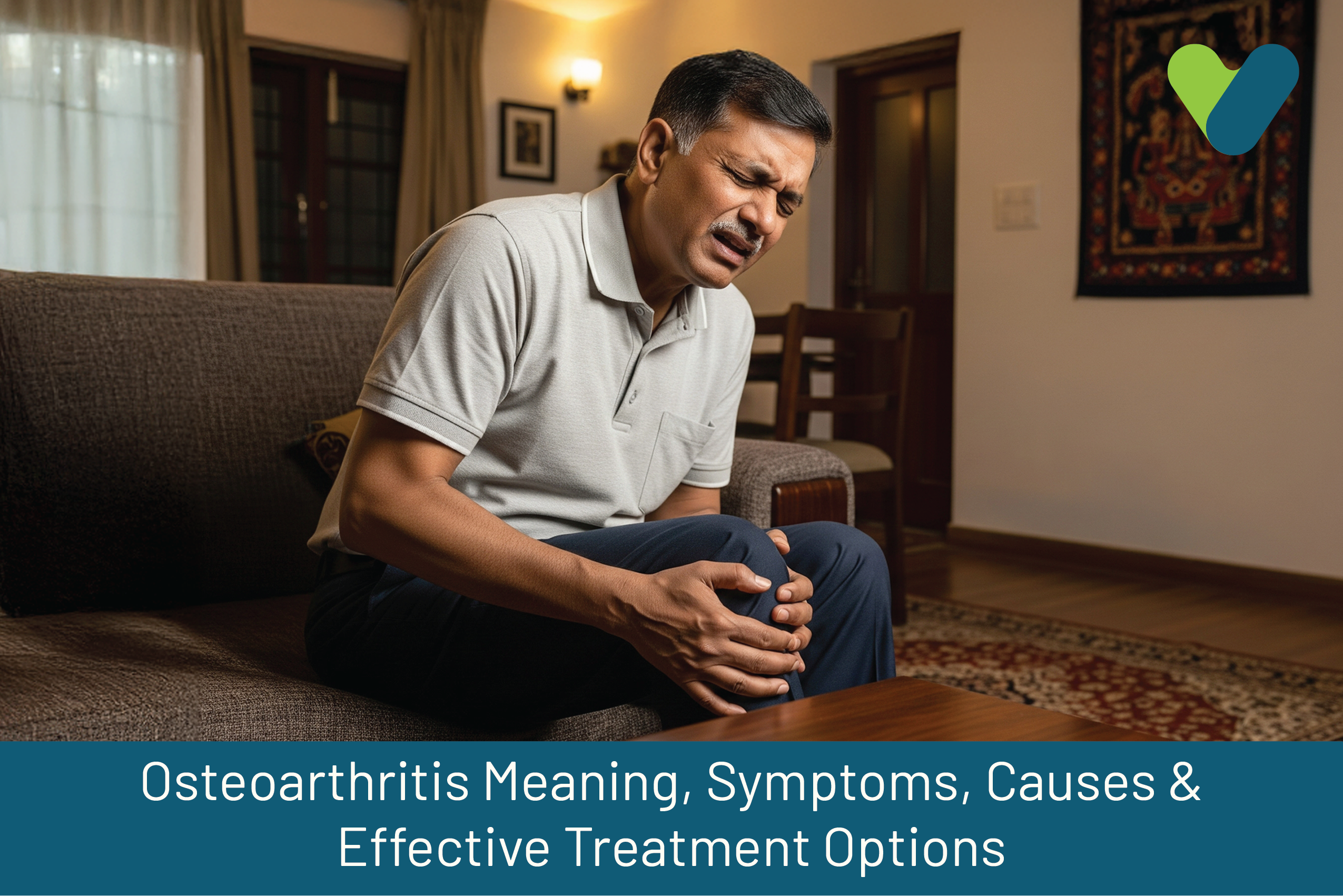One of the most widespread chronic joint disorders is osteoarthritis, which strikes millions of people all over the world. Osteoarthritis is characterized by the gradual deterioration of cartilage, the protective tissue that covers the ends of bones, leading to stiffness, pain, and reduced mobility.
Due to ageing populations, more sedentary or, on the other hand, excessively physically demanding lifestyles, osteoarthritis is on the rise. Although it is common, osteoarthritis is not understood by many, and it is commonly confused with other types of arthritis or regarded as an unavoidable aspect of life as people age.
Nevertheless, it is possible to manage osteoarthritis with early diagnosis, lifestyle changes, and proper management, so that the quality of life is not impaired. So what is osteoarthritis? This article will delve into the definition of osteoarthritis, its symptoms, causes, diagnosis, and various treatment options, as well as provide tips on living with it.
What is Osteoarthritis? (Meaning of Osteoarthritis)
So, what is osteoarthritis meaning exactly?Osteoarthritis (degenerative joint disease or wear-and-tear arthritis) is a long-term condition affecting the joints, which develops when the cartilage in the joints deteriorates. This degradation accelerates the wearing out of the bones against each other, resulting in pain, swelling and a drop in the flexibility of the joints.
Osteoarthritis meaning:
- It refers to the "inflammation of the joint" (arthr = joint, itis = inflammation), but unlike other forms of arthritis, osteoarthritis is primarily mechanical rather than inflammatory.
- It’s a progressive condition, meaning it worsens over time, especially without proper care.
- Osteoarthritis most commonly affects the knees, hips, hands, spine, and feet, though any joint in the body can be affected.
Causes of Osteoarthritis
Osteoarthritis doesn't stem from a single cause; rather, it results from a combination of factors that influence how your joints function and wear over time. The condition can develop slowly and often worsens with age, but several variables may increase your chances of developing it.Common causes and risk factors include:
- Age: The likelihood of developing osteoarthritis increases significantly with age. This is primarily due to the natural breakdown of cartilage and joint tissues over time. As we age, cartilage loses its elasticity and becomes more susceptible to damage and wear, making older adults particularly vulnerable.
- Genetics: Family history plays a notable role. If your parents or grandparents had osteoarthritis, especially at a younger age, your risk may be higher due to inherited genetic traits that affect joint structure, collagen production, or cartilage quality.
- Joint injuries: Trauma from accidents, sports-related injuries, or repeated minor joint injuries can hasten cartilage deterioration. Even if an injury heals, it may alter the biomechanics of the joint, increasing the risk of future osteoarthritis.
- Obesity: Carrying excess body weight increases mechanical stress on joints, especially on weight-bearing joints such as the knees, hips, and spine. Furthermore, fat tissue releases inflammatory chemicals (cytokines) that can damage cartilage over time.
- Repetitive use: Occupations or hobbies that require continuous or repetitive joint motion (like kneeling, heavy lifting, or squatting) may lead to cumulative stress on certain joints. This accelerates the wear-and-tear process, especially in hands, knees, or shoulders.
- Gender: Studies show that women are more likely than men to develop osteoarthritis, particularly after menopause. Hormonal changes, differences in joint alignment, and biomechanics may explain this gender disparity.
- Bone deformities: Some individuals are born with malformed joints or defective cartilage, which can cause uneven wear and early breakdown of joint tissue. Structural abnormalities increase friction and instability in joint motion.
- Other medical conditions: Certain conditions, such as rheumatoid arthritis, gout, Paget's disease of bone, or diabetes, may raise your risk. These diseases can lead to inflammation, metabolic imbalance, or abnormal bone formation, all of which contribute to joint degeneration.
Additional triggers include:
- Sedentary lifestyle: A lack of physical activity weakens muscles that support joints, making the joints more vulnerable to damage. Over time, immobility also limits joint lubrication, contributing to stiffness and discomfort.
- Nutritional deficiencies: Low levels of vitamin D, calcium, and omega-3 fatty acids can impair bone and cartilage health. A poor diet may also increase inflammation and reduce the body's ability to repair tissues.
- Hormonal changes: Especially in postmenopausal women, reduced estrogen levels may influence cartilage metabolism and fluid retention in joints. These hormonal fluctuations can trigger or worsen osteoarthritis symptoms.
- Joint malalignment: Poor posture, leg length discrepancies, or uneven weight distribution can put uneven stress on certain joints, leading to asymmetrical cartilage damage over time.
- Infections or inflammation: Past joint infections or chronic low-grade inflammation may lead to long-term cartilage deterioration if left untreated.
Osteoarthritis Symptoms
Recognising osteoarthritis symptoms early is crucial for slowing progression and improving your quality of life. Symptoms can vary in intensity and frequency, depending on the affected joint, your overall health, and the stage of the disease. While it may start with mild discomfort, symptoms can worsen over time, becoming debilitating if untreated.Common symptoms include:
- Joint pain: This is often the first and most prominent symptom. Pain tends to worsen with movement or prolonged use and often improves with rest. For example, knee pain may become noticeable after walking long distances or climbing stairs.
- Stiffness: Particularly after waking up in the morning or after sitting for long periods. Morning stiffness generally lasts less than 30 minutes, distinguishing osteoarthritis from inflammatory arthritis.
- Reduced range of motion: As the cartilage breaks down and joint structures become altered, moving the joint fully can become difficult or painful. Tasks like bending, twisting, or squatting may become harder.
- Swelling: Mild inflammation or fluid buildup can cause the affected joint to appear swollen and feel warm. This often accompanies flare-ups.
- Joint tenderness: Even light pressure over the joint may cause soreness. The area may also be sensitive to touch or during movement.
- Grinding or cracking sounds: Known as crepitus, this symptom occurs when rough joint surfaces rub against each other during motion. This may sound like clicking, crunching, or popping.
- Bone spurs (osteophytes): These are extra pieces of bone that may form around the joint edges due to ongoing degeneration. They may limit movement and cause discomfort if they press on surrounding tissues.
- Joint instability: Especially in the knees, the joint may feel like it's "giving way" or buckling under pressure, making walking or standing risky.
Other possible signs
- Pain that worsens in damp or humid weather: Changes in barometric pressure may affect joint pressure and nerve sensitivity, intensifying pain temporarily.
- Fatigue and lack of energy: Persistent pain can interfere with sleep and daily activity, leading to tiredness, mood changes, or even depression.
- Visible joint changes: In advanced cases, joints may look misshapen or misaligned due to cartilage loss and bone growth.
Osteoarthritis Diagnosis
The diagnosis of osteoarthritis cannot be made simply by identifying joint pain. Because many types of arthritis overlap in their symptoms, physicians employ a multipronged approach to arrive at a diagnosis, which includes your medical history, physical examination, and diagnostic tests.Steps in osteoarthritis diagnosis:
- Medical history review: Your doctor will inquire about your symptoms, including when they started and changed, whether they are aggravated by activity or time of day, and any previous injury. Personal history of osteoarthritis is also a good indicator.
- Physical examination: These include evaluations of joint tenderness, range of motions, swelling and pain, muscular strength, articular position and crepitus (grating sound). Instead, the doctor can trace the way that you walk and move to identify the joint instability.
Imaging tests:
- X-rays: These are the most popular instruments for proving osteoarthritis. X-rays detect joint space narrowing (used to show cartilage loss), bone spurs, and alterations in the shape of the bones. Nevertheless, X-rays, in some cases, do not necessarily relate to the degree of pain.
- MRI (Magnetic Resonance Imaging): MRI is applied in cases where the diagnosis is not clear; MRI takes detailed images of cartilage, ligaments, tendons, and other soft tissues. It can sense abnormalities in cartilage at an early stage before such changes are seen using X-rays.
Lab tests:
- Joint fluid analysis (arthrocentesis): The sample of the fluid taken from the affected joint is examined to exclude infections or gout, or inflammatory diseases. Osteoarthritis is mostly indicated by clear, non-inflammatory fluid.
- Blood tests: Osteoarthritis has no unique blood test used in its diagnosis, but a test, such as ESR or CRP, may be used to rule out other forms of arthritis, which have elevated inflammatory markers, rheumatoid arthritis or lupus.
Additional evaluations:
- Physical therapists can undertake gait analysis and joint loading tests in order to gain an understanding of the effect the disease is having on your mobility and joint dynamics.
- The treatment may occasionally involve the use of ultrasound to detect fluid accumulation or during joint injections.
Osteoarthritis Treatment Options
There is no cure for osteoarthritis, but multiple treatment options can manage symptoms, slow progression, and improve quality of life.1. Lifestyle modifications
- Weight management: Reducing body weight can ease stress on joints.
- Exercise: Low-impact activities like swimming, walking, and yoga strengthen muscles and enhance flexibility.
- Physical therapy: Tailored exercises and techniques improve joint function and reduce pain.
2. Medications
- Pain relievers as recommended by the doctor.
- Topical creams and gels
- Corticosteroid injections: Temporary relief by reducing joint inflammation.
- Hyaluronic acid injections: Help lubricate the joint, mostly used for knee osteoarthritis.
- Supplements: Cartilage supplements are sometimes used, though evidence is mixed.
3. Assistive devices
- Braces or shoe inserts: Provide support and alignment.
- Canes or walkers: Reduce joint load and increase stability.
4. Surgical options (for severe cases)
- Arthroscopy: Minimally invasive surgery to clean out the joint.
- Osteotomy: Realignment of bones to relieve pressure on the joint.
- Joint replacement (arthroplasty): Involves replacing damaged joint parts with artificial ones, commonly done for knees or hips.
Living with Osteoarthritis – Tips for Management
Managing osteoarthritis involves a holistic approach that goes beyond medications and includes mental and physical strategies to improve daily life.Self-care and home strategies:
- Stay active: Movement lubricates joints and strengthens support muscles.
- Use heat and cold packs:
- Heat eases stiffness.
- Cold reduces swelling and numbs pain.
- Healthy diet: Anti-inflammatory foods like fatty fish, fruits, and vegetables may help reduce symptoms.
- Get enough sleep: Fatigue can worsen pain perception.
- Quit smoking: Smoking can speed up cartilage loss and reduce treatment effectiveness.
- Practice stress management: Meditation, deep breathing, and hobbies can help reduce pain focus.
At work:
- Take regular breaks if you sit or stand for long periods.
- Use ergonomic chairs and workspaces.
- Avoid lifting heavy loads or repetitive joint-straining tasks.
Emotional well-being:
- Join osteoarthritis support groups, either online or in your local community.
- Speak with a mental health professional if chronic pain leads to depression or anxiety.
Conclusion
Osteoarthritis is a life-altering yet manageable condition that affects the joints and can diminish your mobility and quality of life. Understanding the osteoarthritis meaning, identifying early osteoarthritis symptoms, and knowing the potential osteoarthritis causes can help you take proactive steps to manage the condition effectively.While there’s no permanent cure yet, a combination of medical treatment, lifestyle changes, and mental resilience can significantly improve the lives of those affected. From daily exercises and smart diet choices to cutting-edge surgical interventions, osteoarthritis treatment today is more diverse and effective than ever.
Whether you’ve just been diagnosed or have been living with the condition for years, know that you're not alone, and with the right knowledge and tools, you can stay active, reduce pain, and lead a fulfilling life.


